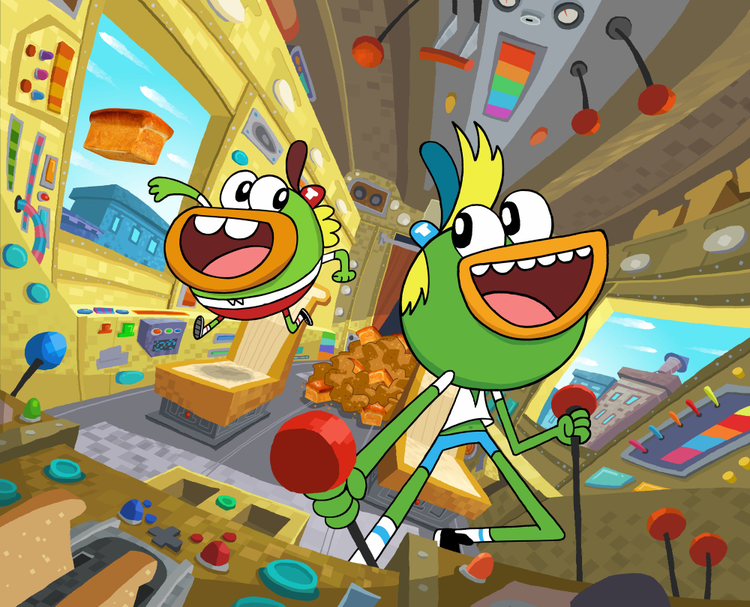Nickelodeon Creates Broadcast-Ready Animation with Adobe Animate CC

From SpongeBob SquarePants and the Ren & Stimpy Show to Teenage Mutant Ninja Turtles and Avatar: The Last Airbender, Nickelodeon has been home to some of the funniest, most action-packed, and most exciting animated shows to hit cable television over the past couple of decades. So, when Adobe was looking for experienced animators to give their advice on the future direction of its animation tools, we turned to animators and directors at Nickelodeon Animation Studios.
By responding to the needs of modern animators, Adobe Animate CC (formerly known as Adobe Flash Professional CC) is an animation tool designed for and by artists. Nickelodeon, Viacom’s leading kids’ brand, provides its animators with Adobe creative apps through the company’s Creative Cloud for enterprise license. We talked to Eric Swanborg, Senior Director of Digital Operations at Nickelodeon Animation Studios, and David Gerhard, Animation Director at Nickelodeon, about the new Adobe Animate CC.

Adobe: How did you get involved in the evolution of Adobe Animate CC?
Swanborg: Adobe came to us looking to have a deep dialog with animators who were working with Adobe Flash Professional. They wanted to know what we were using it for, what features artists were looking for, and what problems we were running into. It was a fantastic experience, and Adobe Animate CC definitely addresses all of the top features on our wish lists.
Gerhard: You can tell that Adobe is intent on making an outstanding animation tool. They really listened to our suggestions and feature requests, improving vectors and brushes to give artists a greater range of styles and textures to work from. But what impressed me was that Adobe didn’t just listen; they tried to anticipate our needs and suggest features that could take our animation to the next level. It felt like a true collaboration, with everyone working together to create the best possible animation tool.
Adobe: How do you decide what type of animation to choose for a series?
Swanborg: There’s no one right animation method. We are a creative-first company, and everything depends on what aesthetic the creator wants, from the style of artwork and lighting to the type of movement. Some productions work best with CGI animation, some with traditional hand-drawn animation, and some with Animate CC.
Gerhard: When creators come to Nickelodeon with a good idea, our development team sets out to work closely with them to develop a short that captures the look and feel of the creator’s vision to help the network decide if it will work as a series. If the style is a crisp, designed look it’s easy to recommend Animate.

Adobe: What are some of the biggest new features of Adobe Animate?
Gerhard: We want every show to have its own unique look and feel to keep things from getting typecast. The vector art brushes coupled with lineweight gives artists an unprecedented ability to customize linework, which can completely change the entire feel of the art style.
Working with vector-based images is one of the key advantages of Animate. Vectors are scalable, reusable, and adaptable. We can resize images depending on whether the character is closer to the camera or far off in the distance. In an era where we’re always looking for more ways to reach audiences with our animation, we have the flexibility to repurpose animation and vectors for social media, web, mobile, or even print without building models from scratch.
Adobe: Why work with Adobe Animate CC?
Gerhard: Adobe Animate makes it fast and easy to rough out animations, especially compared to traditional animation techniques. But then we can take what we’ve created and keep building upon it to produce a broadcast-ready animation—all without ever leaving Animate.
This is huge when we’re building pitches for shows. Some concepts don’t play as well on paper and only shine when the team can see what it looks like in motion. This was the case for our series Breadwinners. With Animate, it didn’t take us long to design characters, add animation and jokes, bring in sound, and publish to YouTube. The network responded once they saw how audiences were responding to Breadwinners and quickly picked it up for a season.

Adobe: Are you planning to use Adobe Character Animator?
Swanborg: We’ve definitely been looking at Adobe Character Animator in Adobe After Effects CC for real-time animation. Between websites, social media, and display ads, there are all sorts of channels nowadays where we can use animation to reach our audience and get people excited about watching our shows. Adobe Character Animator allows us to bring in any character and quickly create new, original animations.
Adobe: How does Adobe Creative Cloud support collaboration at Nickelodeon?
Swanborg: As we get more people registered for Adobe Creative Cloud we’ll be able to benefit more from the sharing and collaboration features. If someone in one production creates a great new brush, they can upload it to Creative Cloud and animators across the company will be able to add it to their set of tools.
Gerhard: Adobe Animate also plays really well with other Adobe creative software. After we create an animation we can use After Effects CC to add lighting and textures. It’s also very scalable in terms of the pipeline. We can start working on a concept with one or two people then scale it way up to 100 people or more working on a series. Overall, Adobe Animate is an incredibly flexible animation tool.
Adobe: Why is the relationship between Nickelodeon and its vendors so important?
Gerhard: We’ve vastly invested with a drive to new programming. Working with vendors, artist tool-makers if you will, is integral to making an artist friendly environment for making animation. Not only does this collaboration with vendors improve the creative experience where the tools are improved for less friction between idea and creation, but ultimately allow new unexplored methods of storytelling and content creation.